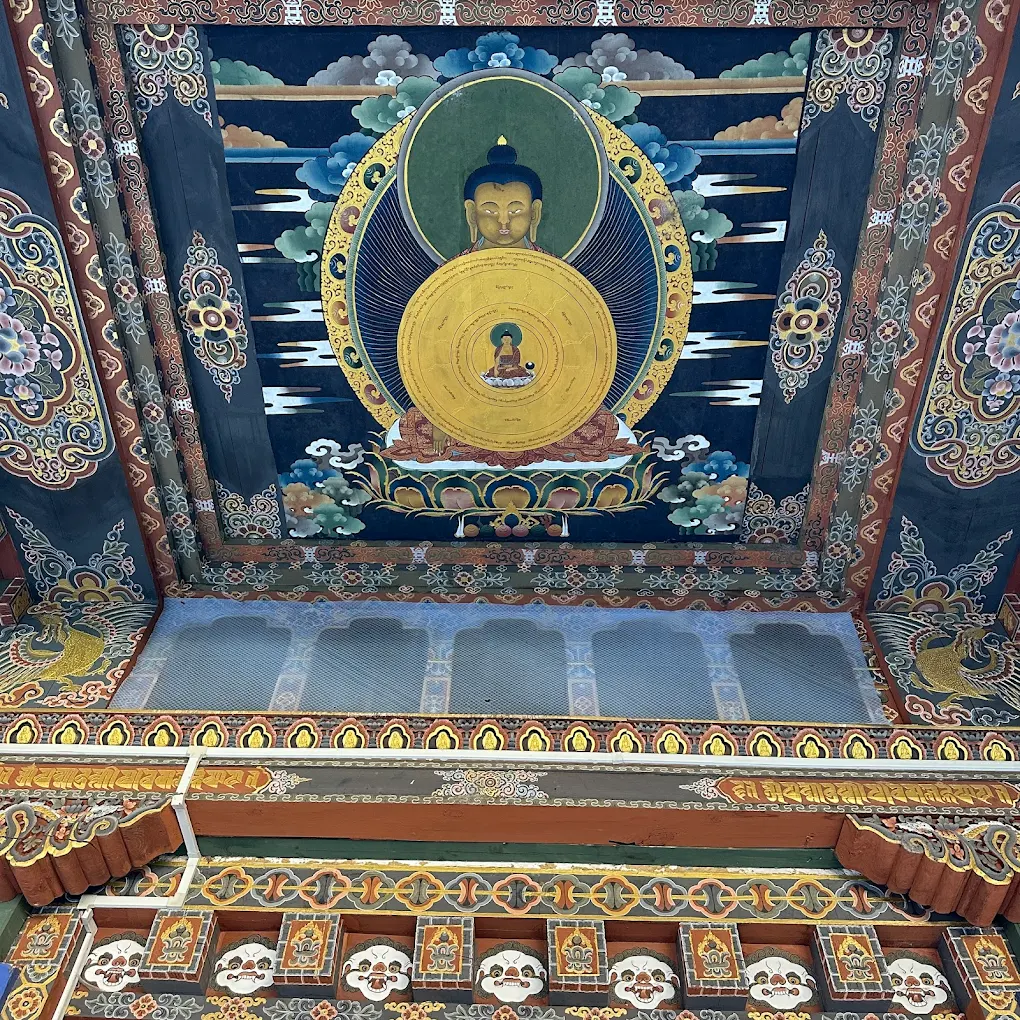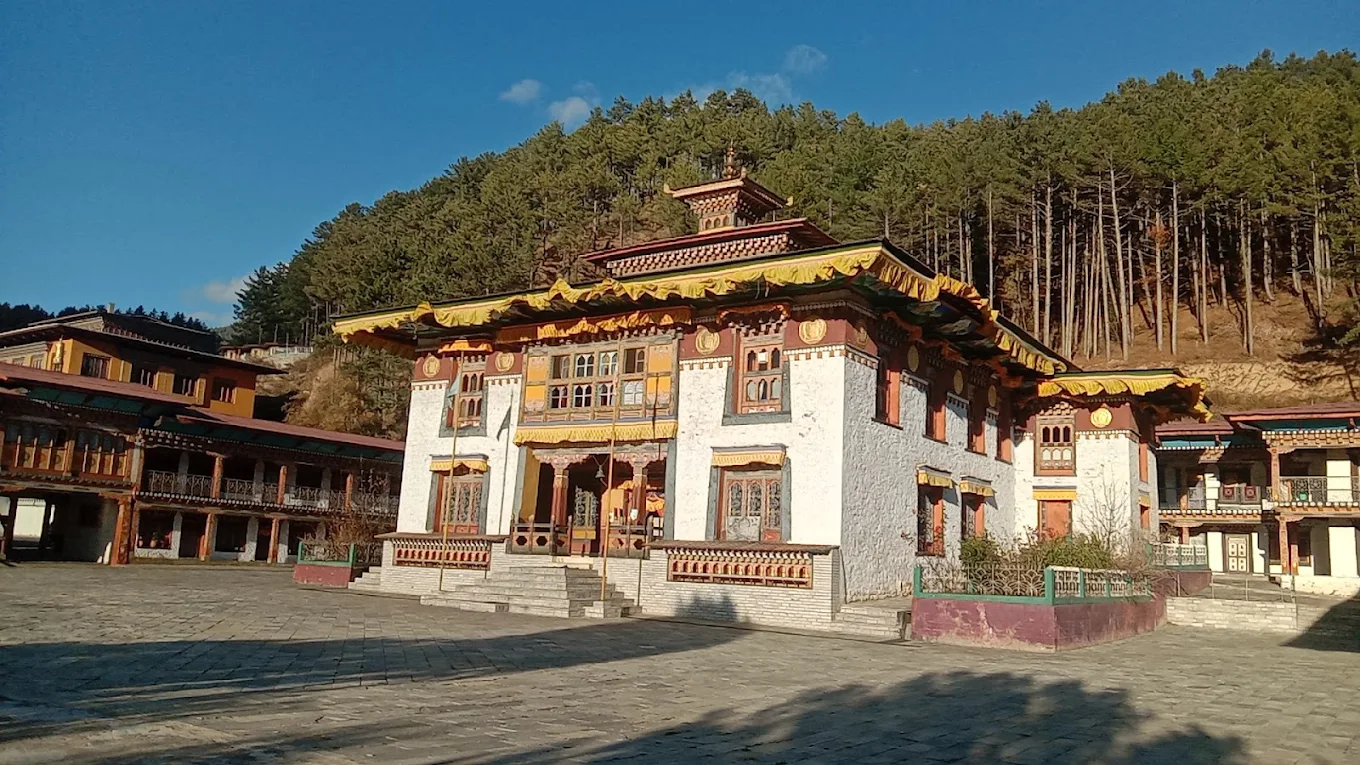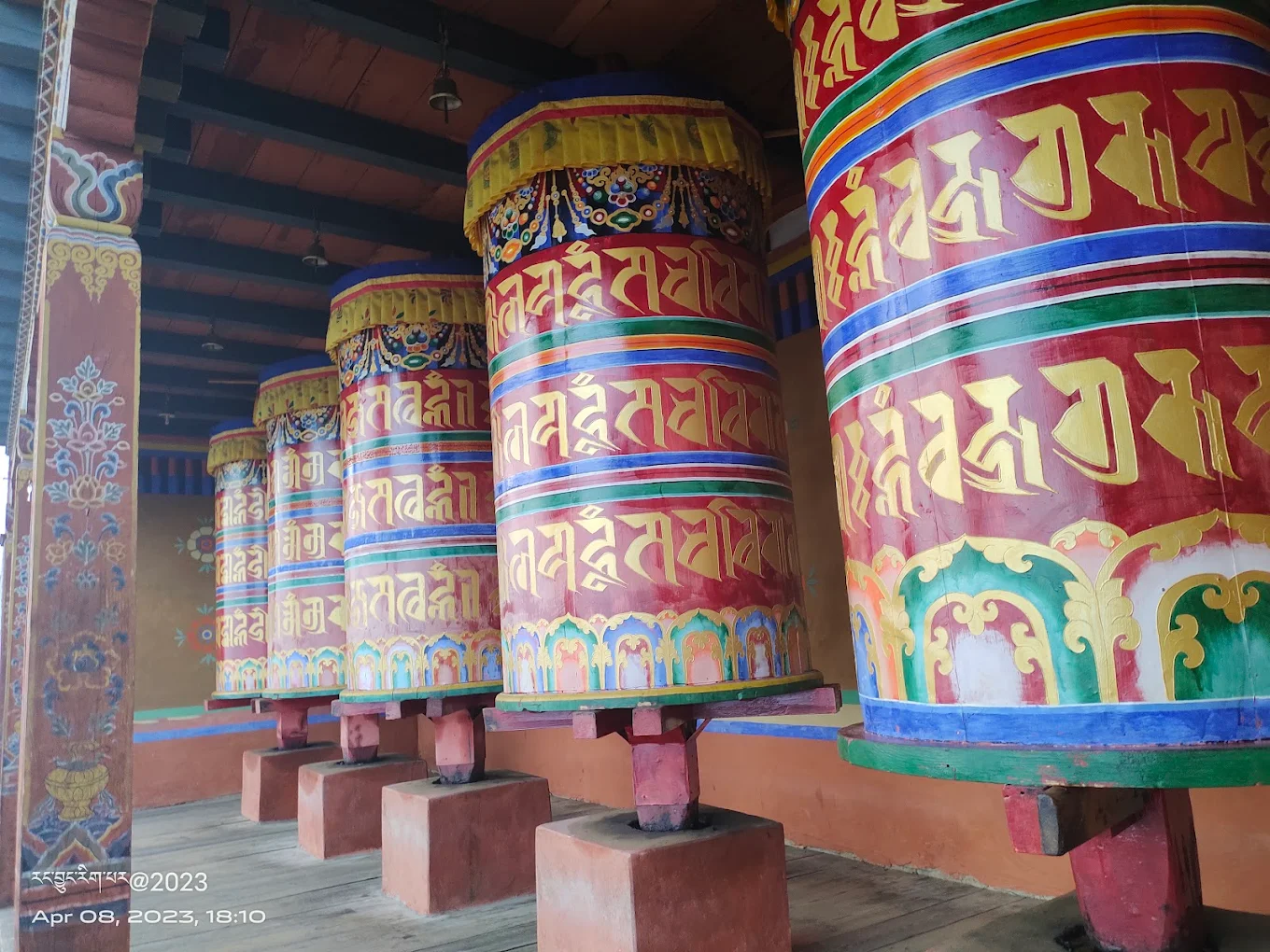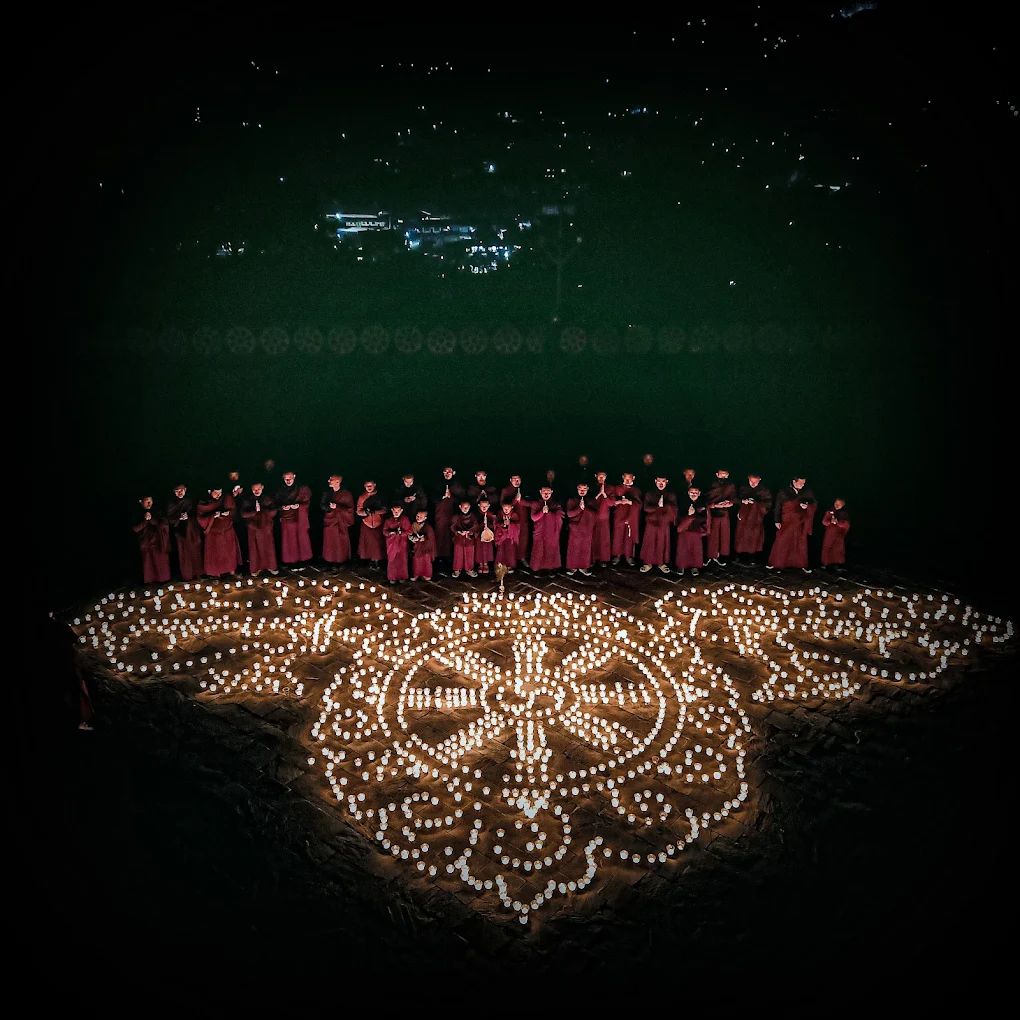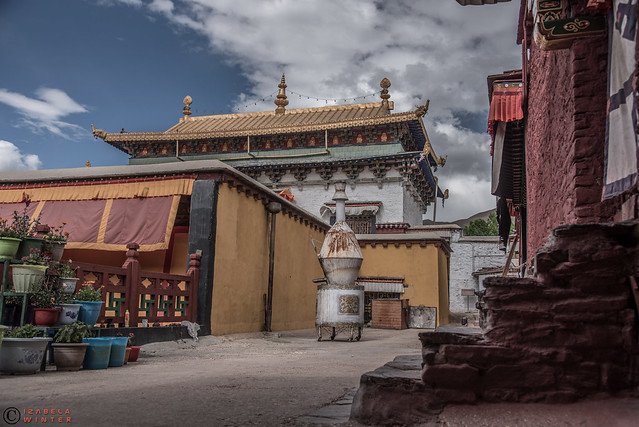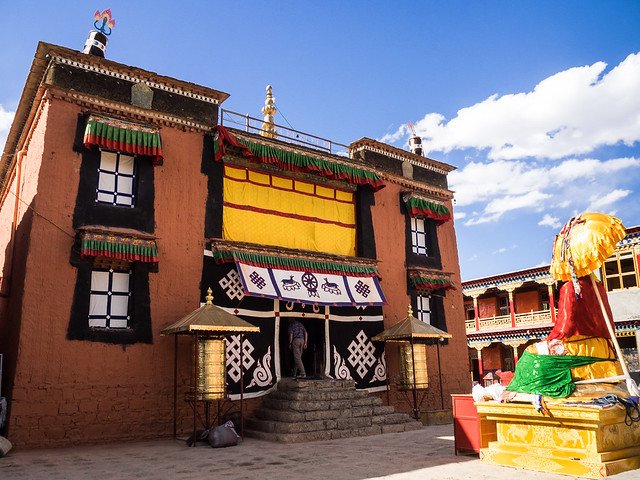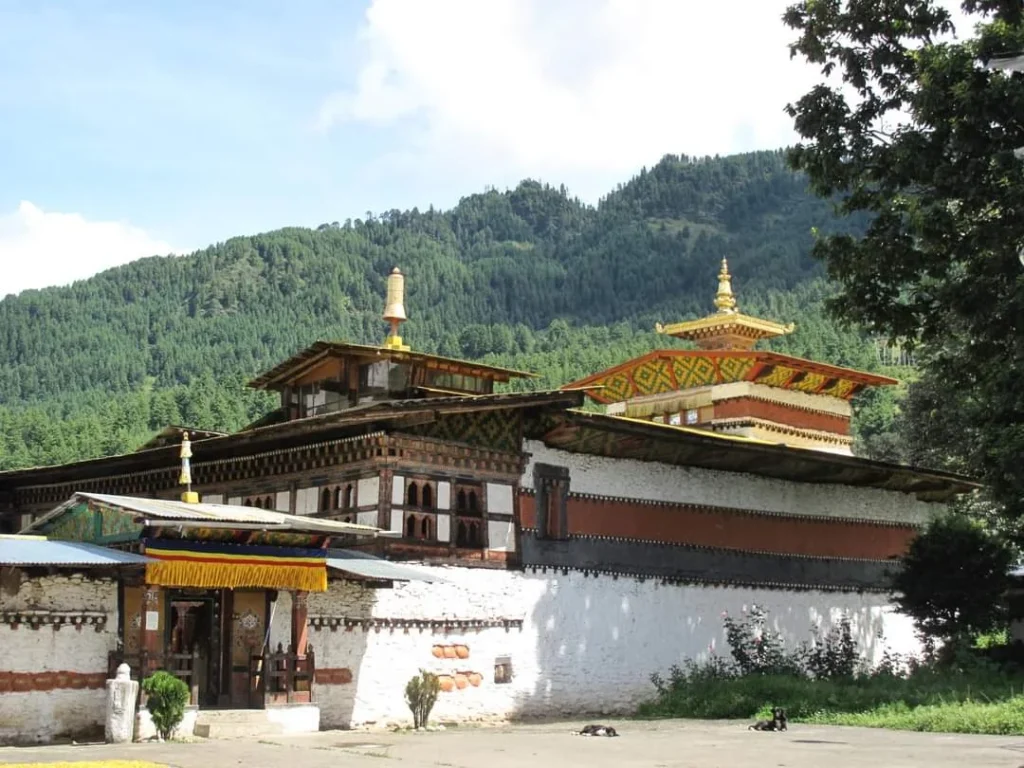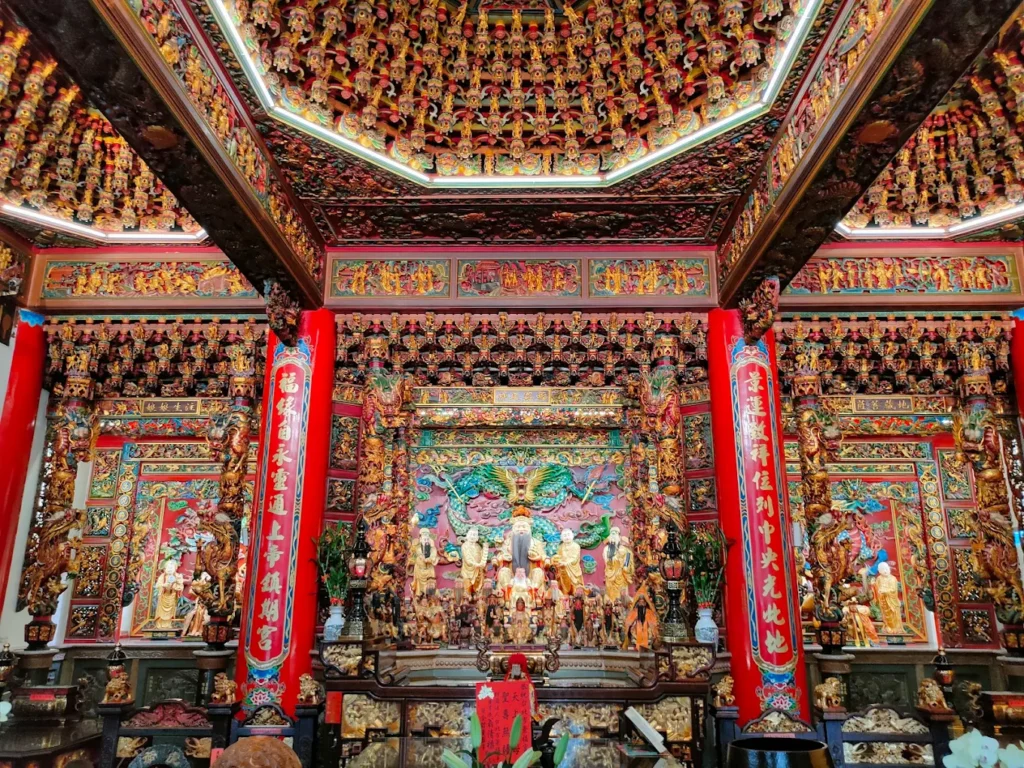Kharchu Dratshang: The Serene Nyingma Citadel of Bumthang’s Spiritual Heights
Perched majestically on a forested hillside overlooking the Chamkhar Valley, where the morning mist clings to the slopes above Jakar town, Kharchu Dratshang rises as a beacon of spiritual tranquility, its stone walls glowing with dawn’s embrace. Within the sacred main temple (lhakhang), monks chant the Guru Rinpoche mantra, their voices resonating around massive statues of Guru Rinpoche, Chenrezig, and Sakyamuni. Founded in the 1980s by Namkhai Nyingpo Rinpoche, this Nyingma monastery of the Jangter tradition serves as a vibrant center for monastic life, its serene presence enhanced by the surrounding Himalayan landscape. The air carries the scent of juniper incense, lit during prayer sessions, while prayer flags flutter against the breeze, blessing the valley below. From its elevated vantage point in Bumthang Dzongkhag, the sweeping vista of Chamkhar unfolds, connecting the dratshang to Bhutan’s spiritual heart. This sacred retreat invites travelers, seekers, and scholars to ascend its trails and immerse themselves in the profound wisdom of Nyingma devotion.
Whispers of Enlightenment: Overview and Significance
Introduction to Kharchu Dratshang
Kharchu Dratshang, situated on a forested slope in Bumthang Dzongkhag, Bhutan, at an elevation overlooking Jakar town, stands as a revered Nyingma monastery of the Jangter tradition, celebrated for its role as a monastic and educational center. A hike or drive from the Chamkhar River bridge reveals a tranquil retreat where the rustle of trees and the sound of monastic debates create a peaceful ambiance. Established in the 1980s by Namkhai Nyingpo Rinpoche, it embodies Bhutan’s Nyingma heritage, blending meditation with scholarly pursuits. A cultural and spiritual landmark, the dratshang weaves history, learning, and Himalayan reverence into a timeless refuge.
Historical Journey
Kharchu Dratshang was founded in the 1980s by Namkhai Nyingpo Rinpoche, a reincarnated lama recognized at age six by the 16th Karmapa, tracing his lineage to one of Guru Padmasambhava’s 25 disciples. The monastery, built with support from the Fourth King Jigme Singye Wangchuk and international patrons, began as a modest temple and grew into a complex with a tshokhang (assembly hall) and retreat centers. A study center was established in 1994, and a practice center in 1996, expanding its role to include shedra (course work), drupdra (meditation), and monastic rituals. Ongoing community efforts have preserved its sanctity, reflecting its evolution as a spiritual hub.
Cultural Significance
- Nyingma Devotion: Rooted in the Nyingma school’s Jangter tradition, the dratshang venerates Guru Rinpoche, Chenrezig, and Sakyamuni, emphasizing Dzogchen meditation.
- Bhutanese Heritage: A spiritual and educational anchor, it preserves rituals like mantra recitation and debating, reflecting national identity.
- Monastic Legacy: Its role as a residence for over 400 monks enhances its spiritual influence.
- Regional Influence: Pilgrimages draw devotees from Bumthang and central Bhutan, fostering community ties.
Unique Legacy
- Hillside Perch: Its forested slope overlooking Chamkhar distinguishes it among Bhutan’s monasteries.
- Jangter Tradition: The lineage of Namkhai Nyingpo Rinpoche holds sacred potency.
- Educational Resilience: The 1994 shedra and 1996 drupdra reflect Bhutanese commitment to learning.
- Cultural Symbol: Its debating tradition mirrors Bhutan’s intellectual heritage.
Community and Global Impact
- Local Devotion: The dratshang hosts prayers and debates, strengthening Bumthang’s Nyingma ties.
- Pilgrimage Hub: Visitors are drawn by its monastic life and valley views.
- Global Appeal: International scholars and meditators seek its Dzogchen teachings.
- Cultural Dialogue: Shared rituals unite Bhutanese and global visitors.
Modern Relevance
- Spiritual Retreat: Kharchu Dratshang offers a haven for mindfulness in its hillside seclusion.
- Cultural Preservation: It safeguards Nyingma practices, ensuring Bhutan’s heritage endures.
- Educational Role: The shedra supports monastic education, inspiring spiritual growth.
Historical Anecdotes
- Rinpoche’s Founding: Namkhai Nyingpo’s 1980s establishment shaped its sanctity.
- Royal Support: The Fourth King’s backing marked its growth.
- Debating Tradition: Monastic debates add to its vibrancy.
Social Role
- Community Hub: Prayers and debates unite Bumthang’s Buddhists.
- Educational Center: Monks train in Nyingma philosophy, nurturing spiritual depth.
- Charitable Spirit: Communal support reflects Nyingma compassion.
Artistic Influence
- Thangka Art: Murals of Guru Rinpoche inspire Bhutanese artists.
- Cultural Icon: The Chamkhar view graces local imagery.
- Festival Art: Prayer flags showcase Bhutanese craftsmanship.
Kharchu Dratshang’s hillside aerie, where Namkhai Nyingpo Rinpoche established a spiritual legacy, weaves a narrative of devotion and learning that defines Bhutan’s Nyingma heritage. From its 1980s founding to its role as a monastic center, the dratshang’s history resonates with the wisdom of Chamkhar Valley, uniting monks and scholars. Its sacred halls and scenic trails set the stage for an architectural tapestry that mirrors its Himalayan soul. As we delve into its physical and spiritual features, Kharchu Dratshang’s design reveals how its elevated beauty nurtures profound meditation and intellectual pursuit.
Crafted by the Slope: Architectural and Spiritual Features
Iconic Design
Kharchu Dratshang’s architecture blends Nyingma simplicity with its forested hillside setting, creating a sanctuary that harmonizes with Bumthang’s valley landscape. Stone walls and wooden roofs, adorned with prayer flags, rise from the slope above Jakar town, reflecting Buddhist austerity. The multi-building layout, centered on the tshokhang, prioritizes monastic and educational functions, with courtyards fostering community. Its perch overlooking the Chamkhar River enhances its sacred resonance, tying the dratshang to Bhutan’s Himalayan ethos.
Key Structures
- Tshokhang (Assembly Hall): The spiritual core, housing statues of Guru Rinpoche, Chenrezig, and Sakyamuni, built in the 1980s.
- Shedra (Study Center): Established in 1994, a space for monastic education.
- Drupdra (Practice Center): Founded in 1996, a retreat area for meditation.
- Monk Quarters: Dormitories for over 400 monks, expanded over decades.
- Chorten Courtyard: A terrace area with prayer wheels, used for debating.
- Retreat Centers: Facilities above the temple for advanced meditation.
Worshipped Statues
- Guru Rinpoche (Padmasambhava): A massive bronze statue, symbolizing wisdom, radiates spiritual guidance.
- Chenrezig (Avalokitesvara): A large statue, representing compassion, stands prominently.
- Sakyamuni (Buddha): A central figure, embodying enlightenment, flanks the altar.
- Spiritual Role: Monks offer butter lamps to Guru Rinpoche, seeking blessings.
Materials and Techniques
- Construction: Local stone and timber, joined with traditional methods, ensure durability.
- Artistry: Murals and thangkas, painted with mineral dyes, reflect Nyingma style.
- Cultural Essence: The design prioritizes monastic simplicity, distinct from dzongs.
Signature Elements
- Tshokhang Statues: The massive trio anchors spiritual practice.
- Hillside Slope: The forested perch offers a serene retreat setting.
- Prayer Flags: Fluttering flags carry blessings across the valley.
Lesser-Known Features
- Ancient Murals: Paintings in the tshokhang depict Guru Rinpoche’s life.
- Debating Terrace: A courtyard for monastic debates, a unique feature.
- Old Prayer Wheel: A weathered mani wheel, in use since the 1980s.
Preservation Efforts
- Expansion (1980s–1990s): Built with royal and community support, preserving original design.
- Challenges: Slope erosion affects stonework, requiring maintenance.
- Modern Additions: Solar lights enhance evening accessibility.
Environmental Integration
- Slope Harmony: The dratshang’s design respects Bumthang’s forest ecosystem.
- Eco-Practices: Monks maintain trails and protect flora.
- Wildlife Haven: Birds nest nearby, enhancing serenity.
Artisan Narratives
- Mural Painters: Local artists restored thangkas, preserving Nyingma art.
- Stone Masons: Craftsmen built the tshokhang, blending tradition.
- Flag Weavers: Nuns crafted prayer flags, embedding blessings.
Symbolic Details
- Prayer Flags: Five colors balance elements, spreading dharma.
- Chortens: Represent the Buddha’s mind, guiding debates.
- Statues: Reflect Nyingma wisdom and compassion.
Landscape Integration
- Hillside Perch: Enhances meditative and educational focus.
- Chamkhar Vista: The valley mirrors inner peace.
- Pine Forests: Provide solitude and spiritual resonance.
Kharchu Dratshang’s stone lhakhangs and sacred courtyards, overlooking Chamkhar Valley, are more than architectural marvels; they are sanctuaries for the Nyingma practices that define its spiritual soul. The statues of Guru Rinpoche, illuminated by butter lamps, anchor rituals that connect monks to Bhutan’s spiritual lineage. These hallowed spaces, alive with chants and debates, invite visitors to engage with the dratshang’s living traditions. As we explore its rituals, Kharchu Dratshang’s role as a meditative and scholarly retreat comes to life, guiding devotees toward enlightenment and wisdom.
Rites of the Scholars: Rituals and Practices
Daily Sacred Rites
- Morning Chanting: Monks recite the Guru Rinpoche mantra at dawn, fostering wisdom.
- Meditation Sessions: Silent meditation, held twice daily, centers on Dzogchen practices.
- Butter Lamp Offerings: Devotees light lamps before Guru Rinpoche, praying for blessings.
Unique Practices
- Monastic Debating: Monks engage in theological debates on the terrace, a Jangter tradition.
- Long-Life Prayers: Tse drup ceremonies seek longevity, led by senior lamas.
- Signature Ritual: Offering khata scarves during debates, tied to intellectual legacy.
Festival Traditions
- Kharchu Drupchen (dates vary): A multi-day festival with cham dances and prayers.
- Monlam Chenmo (10 days prior to Drupchen): A prayer ceremony by monks, preceding the festival.
- Lhabab Duchen: Ceremonies honor the Buddha’s descent, with chorten circuits.
- Statue Veneration: Guru Rinpoche’s statue is adorned with silk during festivals.
Visitor Engagement
- Accessible Rituals: Visitors can join chants or observe debates, guided by monks.
- Offerings: Butter lamps and prayer flags, available at the dratshang, invite participation.
- Nyingma Etiquette: Bow before statues and maintain silence during rituals.
Spiritual Community Roles
- Monastics: Over 400 monks, including shedra students, lead rituals and studies.
- Lamas: Senior monks guide debating and tse drup practices.
- Lay Devotees: Bumthang villagers maintain trails and support events.
Interfaith Connections
- Syncretic Practices: Some blend Nyingma rites with local traditions, honoring spirits.
- Outreach: Festivals welcome diverse faiths, fostering unity.
- Education: Monks share Dzogchen teachings with visitors.
Ritual Symbolism
- Butter Lamps: Represent wisdom illuminating knowledge.
- Khata Offerings: Symbolize purity and devotion.
- Cham Dances: Enact spiritual harmony and debate victories.
Seasonal Variations
- Spring Rites: Vibrant with valley blooms, ideal for Drupchen.
- Winter Retreats: Cold enhances shedra focus.
- Monsoon Chants: Rain amplifies mantra resonance.
Monastic Life
- Daily Routine: Monks rise at 4:00 AM for chants, meditation, and studies.
- Community Service: Monks guide visitors and maintain the dratshang.
- Training Hub: Shedra monks learn Nyingma philosophy, supporting Bumthang’s faith.
Kharchu Dratshang’s rituals, from the Guru Rinpoche mantra to monastic debates, breathe life into its hillside sanctuary, connecting devotees to the Nyingma lineage. The dratshang’s spiritual practices, rooted in Bhutan’s intellectual faith, invite visitors to engage with its scholarly heart, whether through chants or observing debates. For travelers, these rites offer a glimpse into Bumthang’s sacred traditions, accessible within its forested grounds. As we turn to visitor information, Kharchu Dratshang’s hillside setting guides practical planning, ensuring a meaningful journey to this serene retreat.
Journey to the Slope: Visitor Information
Navigating to Kharchu Dratshang
- Location: Bumthang Dzongkhag, overlooking Jakar town, accessible via a trail from the Chamkhar River bridge.
- Landmarks: Opposite Jakar Dzong, with Dzongkha and English signs near the bridge.
- Routes: Hike from the bridge (20–30 minutes) or drive to the base and walk.
Address of Kharchu Dratshang
- Dzongkha: Kharchu Dratshang, Bumthang Dzongkhag, Bhutan.
- English: Kharchu Dratshang, Bumthang District, Bhutan.
Visiting Hours and Etiquette
- Hours: Open daily, 6:00 AM–6:00 PM, with debates and prayers varying by schedule.
- Etiquette: Dress modestly, remove shoes before lhakhang, and avoid disturbing rituals.
- Nyingma Custom: Offer butter lamps with both hands and bow to statues.
Transport Options
- By Foot: Hike from the Chamkhar River bridge (20–30 minutes, moderate difficulty).
- By Vehicle: Drive to the bridge approach, then walk the slope.
- By Horse: Local guides may offer horses, arranged at the base.
Accessibility and Safety
- Mobility: Steep trails may challenge those with mobility issues; no ramps available.
- Safety: Stable paths with guideposts; carry water for the climb.
- Tips: Wear sturdy hiking boots and bring layers for weather changes.
Amenities and Surroundings
- Facilities: Basic restrooms near the dratshang; no shops on-site.
- Nearby: Jakar Dzong and Jambay Lhakhang, within 1–2 km, offer cultural experiences.
- Dining: Picnic areas encourage packed meals, with options in Jakar town.
Immersive Visitor Tips
- Best Timing: Early morning visits offer quiet chants and cooler weather.
- Sensory Moments: Inhale pine-scented air and hear debate sounds.
- Statue Connection: Offer butter lamps to Guru Rinpoche and reflect briefly.
- Debate Planning: Observe monastic debates in the courtyard if scheduled.
Nearby Cultural Experiences
- Jakar Dzong: A historic fortress, 1 km away, blends spirituality and history.
- Jambay Lhakhang: A 7th-century temple, 2 km away, holds ancient relics.
- Mebar Tsho: The Burning Lake, 5 km away, offers spiritual significance.
Photography Tips
- Best Angles: Capture the tshokhang at sunrise for golden light.
- Respectful Shots: Avoid photographing debates or prayers without permission.
- Scenic Views: The Chamkhar Valley offers stunning vistas.
- Equipment: A lightweight camera suits the trek.
The journey to Kharchu Dratshang, guided by Bumthang’s hillside trails, is a pilgrimage that blends spiritual discovery with intellectual pursuit, inviting visitors to engage with its Nyingma traditions. The dratshang’s lhakhangs and courtyards, vibrant with chants and debates, offer a window into Bhutan’s sacred heart, where wisdom feels accessible. Beyond its hillside beauty, Kharchu Dratshang’s deeper cultural and spiritual significance enriches the experience, revealing the essence of Himalayan Buddhism. As we explore these insights, the dratshang’s role as a beacon of learning and faith comes into sharper focus, deepening our connection to its sacred legacy.
Insights of the Slope: Cultural and Spiritual Reflections
Nyingma Philosophy
Kharchu Dratshang embodies Nyingma’s core: compassion and wisdom through Dzogchen meditation and scholarly debate. Guru Rinpoche, Chenrezig, and Sakyamuni inspire devotees, reflected in chants and rituals. Dzogchen teachings emphasize direct realization, guiding monks toward enlightenment.
Environmental Spirituality
The dratshang’s hillside perch ties it to Himalayan reverence for nature. The Chamkhar Valley’s forests and river views foster meditative calm, with offerings honoring local spirits. The landscape invites reflection on harmony with the natural world.
Artistic Symbolism
Murals depict Guru Rinpoche’s wisdom, symbolizing enlightenment. Chortens represent the Buddha’s mind, while prayer flags balance elements. These elements weave Nyingma ideals into the dratshang’s aesthetic.
Community Resilience
Founded by Namkhai Nyingpo Rinpoche’s followers, Kharchu Dratshang reflects Bhutanese devotion to the Nyingma tradition, sustained by community and royal support.
Environmental Stewardship
The dratshang’s slopes foster Buddhist eco-ethics. Monks protect trails and forests, urging visitors to honor the hillside’s sanctity.
Meditative Practices
Nyingma meditation, including Dzogchen, cultivates awareness. The tshokhang offers spaces for retreat and debate, guided by lamas, amplifying inner peace.
Cultural Narratives
- Rinpoche’s Legacy: His founding inspires devotion.
- Debating Tradition: Monastic debates link past and present.
- Festival Lore: Kharchu Drupchen carries Nyingma traditions.
Historical Context
- Nyingma Roots: Namkhai Nyingpo’s lineage shapes its identity.
- Royal Support: The Fourth King’s backing defined its growth.
- Educational Continuity: The shedra ensures its legacy.
Reflecting on the Journey
Kharchu Dratshang, cradled on Bumthang’s sacred hillside, is a sanctuary where wisdom meets enlightenment. Its lhakhangs and courtyards, alive with Guru Rinpoche’s legacy, embody Bhutan’s Nyingma soul, inviting all to seek knowledge. The dratshang’s trails, worn by centuries of monks, tell a story of devotion, rooted in Himalayan faith. Whether meditating before Chenrezig, observing debates, or tracing Bhutan’s scholarly heritage, visitors find a space to reflect and connect. As you descend, the pine scent and prayer flags’ flutter linger, a reminder that wisdom is always within reach.


